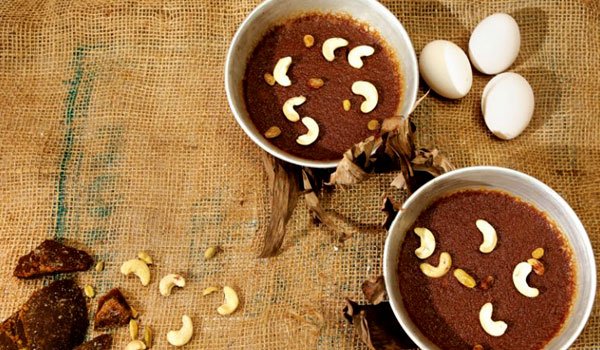Although watalappam is a steamed custard dish that originated in Malaysia, in Sri Lanka its recipe and flavour are quite different. Condensed milk and sugar have been replaced with coconut milk and kitul jaggery, ingredients ubiquitous in Sri Lanka, not to mention much healthier options. The dessert is traditionally prepared in small steel bowls, a popular element of Muslim weddings and festivals. As Ramadan dawns it’s customary for Muslim families and friends to share their festive joy by distributing generous potions of watalappam.
Wanting to find out more, our team went along to Ahamed Raslan’s shop in Wattala in search of the authentic wattalappam recipe.
The key ingredients of watalappam, as in any custard, are eggs and coconut milk. Kitul jaggery is the all-important sweetener. A garnish of cashews and raisins adds a variation to the textures of the pudding. Sri Lanka is the world’s spice hub, so obviously we add them to everything we love. Depending on personal taste, various spices are added, the most common being cardamom, cumin, nutmeg, cinnamon and cloves. According to Raslan, in the southernmost parts of Sri Lanka, lime leaves or kaffir lime leaves are added to the mixture to give the pudding a citrusy aroma.
Although the steps for making the pudding are simple, and you don’t need elaborate equipment, it is time-consuming. The first step is to beat the eggs until the mixture attains a light creamy colour. Kitul jaggery is finely sliced and crushed lightly with a knife so that it crumbles. It’s then beaten into the egg mixture until it dissolves. As in all custards, the beating process is of great importance to the final texture. Creamy coconut milk is then beaten into the pudding mixture.
In the past – and in some villages to this day – the mixture is beaten by hand, a slow process that can take up to an hour. So today most households use electric beaters instead.
The next step is to grind the spices. Equal amounts of cardamom, mace and cumin are ground to a fine powder. The aroma of the spices takes over the room and whets the appetite. About a tablespoon of the spice powder, or as much as you prefer, is then gently folded in. The spices are not just important in terms of flavouring or fragrance. They’re also considered essential as remedies for stomach aches and diarrhoea, and are said to prevent indigestion as a reaction to the eggs. If you suffer from diarrhoea or abdominal pain in a Sri Lankan house, you’ll probably be served cumin water as a cure.
The spices turn the mixture a rich brown colour, almost the colour of chocolate. Watalappam connoisseurs and cooks are extremely pedantic about this shade. Sometimes to make the mixture darker or to make the pudding a little sweeter, caramelized sugar is added: heat sugar in a large pan, adding water once it starts to turn brown; take the syrup off the heat once it has reduced.
The pudding is then separated and the caramelized sugar syrup added to half the mixture, spoon by spoon. Raslan says that you must be careful not to add too much, as the sugar syrup might turn on you and make the pudding bitter! That’s why you separate the mixture and only add the sugar syrup to one half. After the batter is reunited it’s passed through a fine sieve and poured into small steel bowls, leaving room for the pudding to rise. The bowls are then placed within a large, airtight pot to steam.
Traditionally, the puddings are steamed on a wood-fired stove in a large steel pot made airtight with cloth wrapped around it. The tops of the pudding bowls are covered with paper to ensure condensation does not fall into the pudding. Today in most modern households, the puddings are steamed in an electric steamer or even a rice-cooker. After 20 minutes the puddings are pricked with a toothpick or back of a spoon. If nothing sticks to the utensil, the custard has set, so the top is garnished with cashews and raisins and steamed for another five minutes. The puddings are then left to cool to room temperature and served.
Standing a few feet away from this popular Sri Lankan treat, you get a whiff not just of its delectable ingredients, but of something even richer – the distinctive fragrance of cultures combining to create something recognisable but also entirely new.
Ingredients
10 Eggs
250g Kitul jaggery
(or as required)
240ml Coconut milk
(1 coconut)
Cardamom (as required)
Mace (as required)
Cumin (as required)
100g Sugar (optional)
Cashew and raisins for garnish
Words - Keshini de Silva
Photographs - Vishwathan Tharmakulasingham
-Explore Sri Lanka







